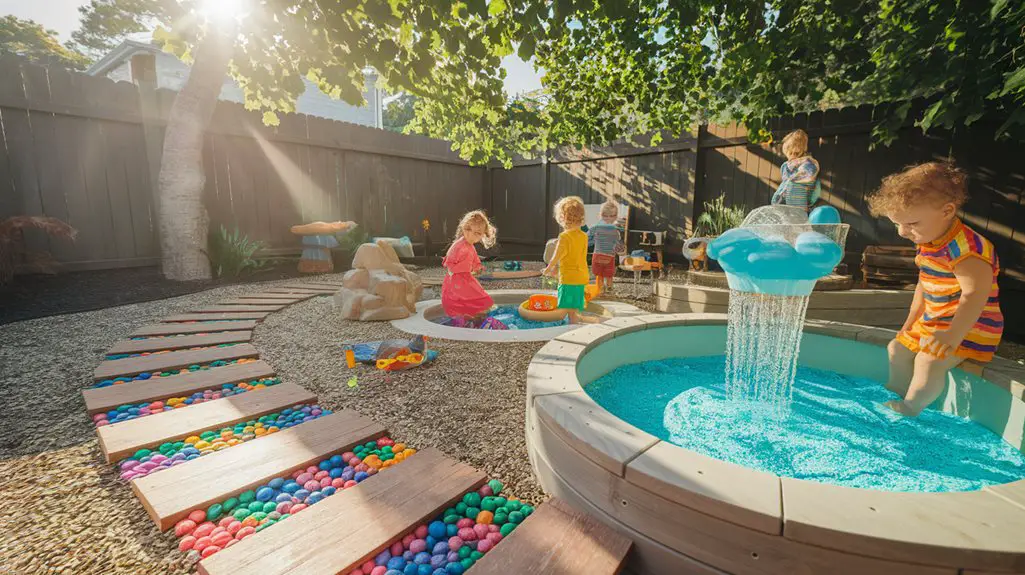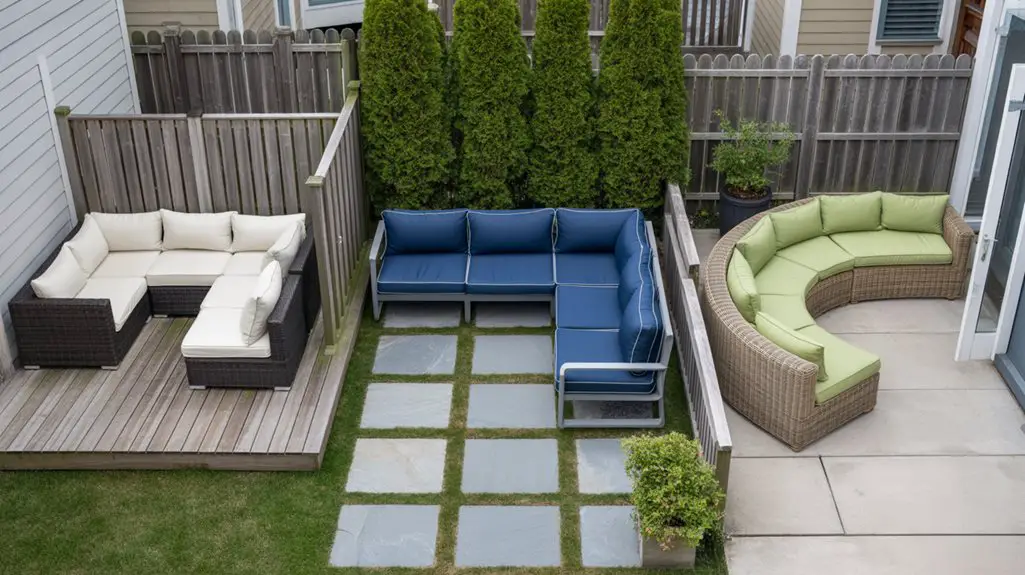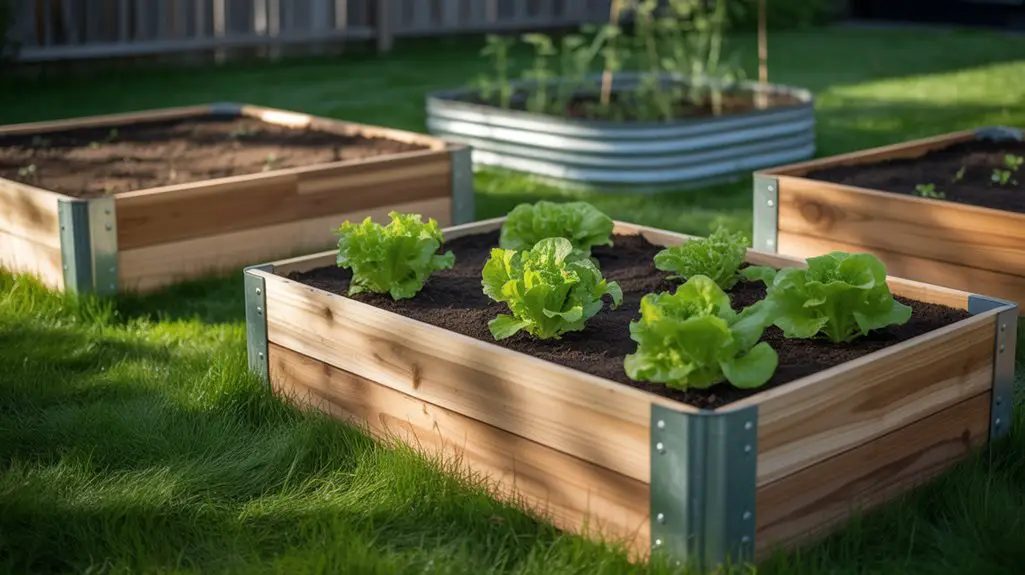Your backyard can become the most powerful developmental tool you’ll ever provide for your child. When you transform outdoor spaces into sensory-rich environments, you’re actively supporting vital neurological pathways that form during early childhood. You’re not just creating play areas—you’re designing multisensory experiences that engage touch, sight, sound, and even taste. What specific elements might constitute an ideal sensory landscape for your child’s developing brain?
Natural Materials: Building Texture-Rich Environments
While traditional playground equipment offers predictable sensory input, natural materials introduce children to variable textures, weights, and resistances that enhance neurological development. When you incorporate stacked stones, logs, and sand pits, you’re creating environmental complexity that stimulates proprioceptive awareness and tactile discrimination.
Consider establishing a nature corner where you’ll collect pinecones, smooth river rocks, and bark pieces that children can sort, stack, and explore. These materials engage fine motor skills while developing sensory processing pathways.
Tree stumps of various heights encourage vestibular development through balancing challenges, while loose materials like leaves and sticks enable creative manipulation. Incorporating natural materials into play areas not only enriches sensory experiences but also promotes physical fitness and exploration for energetic pets.
You’ll notice improvements in children’s sensory integration when they regularly interact with these diverse natural elements, as their nervous systems learn to process and respond to non-uniform stimuli.
Water Play Stations That Stimulate Multiple Senses
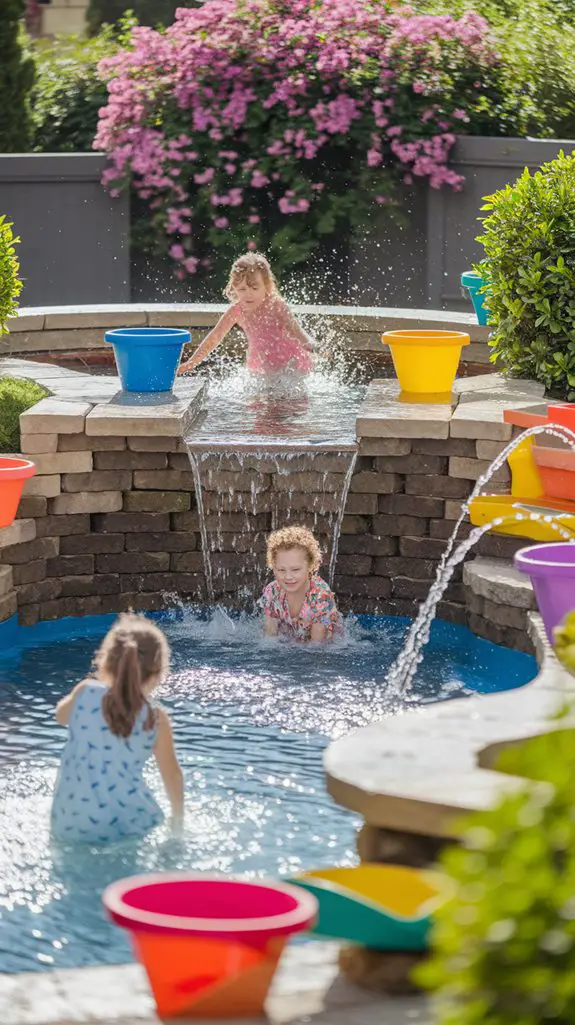
When properly designed, water play stations activate nearly every sensory system simultaneously, making them exceptional features in developmental play spaces.
Consider installing graduated water tables with multiple depths, allowing children to experience temperature variation, tactile stimulation, and visual tracking as water flows between levels.
Add auditory elements through bamboo water chutes, small waterfall features, or rain chains that create distinct sounds when water passes through them.
Enhance proprioceptive feedback by incorporating water pumps requiring different degrees of pressure and resistance.
For maximum sensory integration, include transparent colored tubes where water catches light while moving, creating visual-vestibular connections.
Guarantee accessibility by varying heights of water features to accommodate children of different abilities and developmental stages.
These multisensory stations promote self-regulation, cause-and-effect understanding, and scientific concept development through experiential learning. Additionally, they can foster social interaction as children engage and collaborate during play, enhancing their communication skills.
Sound Gardens: Creating Musical Outdoor Spaces
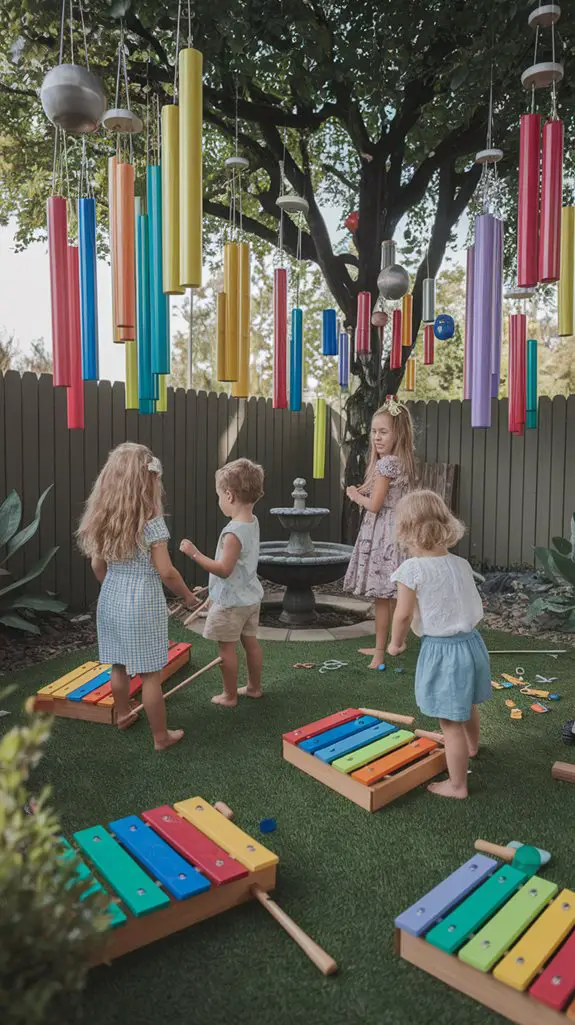
Sound gardens transform ordinary backyard spaces into rich auditory environments that support critical developmental milestones in children’s sensory processing systems. When you install wind chimes, bamboo xylophones, or metal percussion instruments, you’re creating opportunities for cause-and-effect learning and auditory discrimination.
Position instruments at varying heights to accommodate different developmental stages. Include both pitched and non-pitched elements—metal pipes cut to different lengths produce distinct tones, while suspended pots and pans offer unpredictable resonance. You’ll enhance cognitive development by incorporating visual cues that connect sounds to actions.
For ideal sensory integration, combine textures with sounds: rough-textured rainsticks, smooth metal chimes, and wooden drums with different densities. This multisensory approach strengthens neural pathways as children experiment with volume, rhythm, and tone while developing fine and gross motor coordination. Additionally, interactive features such as tactile panels can further enrich the sensory experience in outdoor play zones.
Tactile Pathways and Sensory Walking Trails
Tactile pathways engage a child’s sensory system through deliberate manipulation of ground textures and surfaces in your backyard landscape. These trails incorporate varying materials like smooth river rocks, rough bark chips, cool marble tiles, and soft sand to stimulate proprioceptive awareness and tactile discrimination.
You’ll maximize developmental benefits by designing paths with contrasting adjacent textures, creating opportunities for comparative sensory processing. Install stepping stones at varying heights to enhance vestibular development and balance.
Consider incorporating textured handrails or guide ropes for children with visual impairments or those seeking additional proprioceptive input.
For ideal neurological development, arrange your pathway in a loop with 5-7 different texture zones, each extending at least three feet. This configuration guarantees sufficient exposure to each sensory stimulus while maintaining the child’s engagement throughout the experience.
Edible Gardens: Taste and Smell Exploration Areas
While tactile pathways engage touch and movement, edible gardens activate children’s taste and olfactory senses in complementary ways. Start with child-safe plants like mint, cherry tomatoes, and strawberries that offer distinct aromatic profiles and flavor experiences.
Position herbs at different heights to encourage active exploration and scent discovery.
Design planting beds in geometric shapes with clear boundaries to help children understand spatial relationships while they tend the garden. You’ll notice improved fine motor skills as they pick berries, pull carrots, and pinch herbs. This cultivation process develops patience and causal understanding—connecting care efforts to edible outcomes.
Include a dedicated smelling station with fragrant plants like lavender and lemon balm. These aromatic experiences form neural pathways that enhance memory development and emotional regulation while broadening children’s sensory vocabulary and discrimination abilities. Additionally, incorporating pollinator-friendly herbs can attract beneficial insects that further enrich the sensory experience in the garden.
Conclusion
You’ll witness wonderful growth as your backyard becomes a developmental dynamo. By purposefully positioning play areas that promote proprioception, tactile testing, and sensory stimulation, you’re creating critical connections in your child’s cognitive circuitry. These carefully crafted environments don’t just deliver delight—they’re deliberately designed developmental tools. Your outdoor oasis will transform ordinary afternoons into opportunities for significant sensory advancement, fostering fundamental skills that facilitate future learning.

